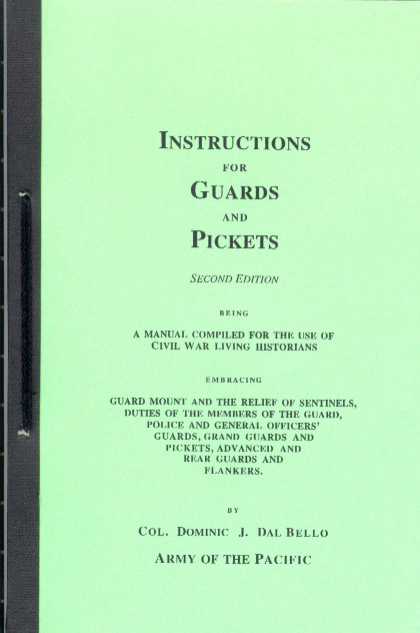| Forward
Of all the duties a soldier must perform,
none is probably more important than Guard Duty. While some
may argue that services in battle are more important, it should be recalled
that those times of actual combat are few, while insuring the safety and
discipline of the Army is continuous duty.
Despite the importance of Guard Duty, putting the proper procedures into
practice has been difficult for the Civil War living historian due to
the difficulty in finding sources which clearly explain the principles.
Even during the War there seems to have been some confusion as to what
exactly was to be done. Brig. Genl. August V. Kautz explains in his Customs
of Service for Officers (1866), that the U.S. Army Regulations,
Art. XXXIII., and Par. 573 to 592,
contain nearly all the Regulations governing the arrangement and duties
of the guard, the posting and instruction of the sentinels. They lack
system and detail, and have been deviated from to some extent by custom,
and therefore deserve the closest attention to enable officers to obtain
a correct knowledge of their duties as officers of the guard.
Instructions for Guards and Pickets is a humble attempt
to present the basic procedures and duties of the Guard. The main sources
are the U.S. Army Regulations (1861), Kautz's Customs of Service
for Non-Commissioned Officers and Soldiers (1864) and Customs of
Service for Officers (1866). For Guard Mount, many of the holes
in the Regulations were filled in using Emory Upton's Infantry
Tactics (1866 and '74 editions). Over two dozen works were referenced
in an attempt to comprehend as much of this subject as possible.
Copious footnotes, both citing the sources, as well as providing more
detailed explanations (perhaps more than the reader may require), are
included. In some cases, it was necessary to reconcile and/or note discrepancies
between the various manuals, and to make conclusions about some of the
details when the works were silent or incomplete.
Those with modern military training will note that the ceremonies and
basic principles of Guard Duty have survived essentially unchanged for
130 years; often the exact wording of the manuals remains the same, a
testimony to military tradition and the practicality of the sentinels'
instructions.
The author has attempted to present the procedures in a brief and elementary
form so that they may be easily understood and quickly learned. Additionally,
the author has tried to be complete - this work actually began as a small
section in another manuscript, but has expanded (at times uncontrollably)
into this compilation. Much detail is presented in an attempt to give
the reader (as well as the l, author), as complete a view of the principles
as practicable. More information is likely presented than the average
reader l will need in practice.
It is hoped that the procedures are presented in a logical order, and
that the figures allow the reader to better visualize what is meant to
occur. As always, the author recommends that the reader consult the primary
sources.
Practicality is urged. For instance, while the full Guard Mount ceremony
is presented, in events where living history units are portraying forces
at "the front," the full ceremony need not be done. Or, the
two-post Camp Guard may be consolidated at one post, as suggested by Kautz
(Para. 166).
The author is indebted to Steve Harness (100th Penn.) for providing a
basic primer of Guard Duty for our 2d California Volunteer Infantry
programs at Ft. Tejon, Calif., and unknown to him, sparking this author's
interest in the subject. In addition, he wishes to thank Steve Dunfee
and the 23d NY for insisting on posting Guard throughout the night on
our campaigns. Both of these gentlemen have also provided valuable advice
and counsel with regards to the ARMY OF THE PACIFIC. The author
would also like to thank Ted Parrott (100th Penn.) and Sean Malis (100th
Penn.) for providing him with additional references.
Col. Dominic J. Dal Bello
ARMY OF THE PACIFIC
March, 1996
|
